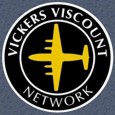
October 1953 to August 1962
British European Airways Corporation (BEA)
G-AMOI - c/n 22 - a V.701 series Viscount
United Kingdom registered
12 October 1953
Registered to British European Airways Corporation (BEA), Keyline House, Ruislip, Middlesex.
14 October 1953
Engine ground running commenced.
20 October 1953
First flight from Brooklands Airfield, Weybridge, Surrey, England.
It landed at Wisley Airfield, Surrey, England for fitting out and test flying.
30 October 1953
Certificate of Airworthiness issued.
5 November 1953
Delivered to British European Airways (BEA) named as 'R M A Sir Hugh Willoughby'.
It was fitted with Rolls-Royce Dart RDa3 Mark 505 engines with serial numbers: 1117 & 1075 on the port side and 1116 & 1139 on the starboard side.
The cabin was fitted out with a 47 seat all-tourist class layout.
Vickers-Armstrongs (Aircraft) Ltd invoice C/VW/51497 dated 6 November 1953
Amount £190,314 7s 8d + £163 13s 5d (delivery fuel + 3% fuel handling charge + oil).
8 July 1954
During a flight from London Airport (Heathrow), Middlesex, England to Schiphol Airport, Amsterdam, Netherlands along Airway Amber 10, still in UK airspace, a near miss was reported with a USAF aircraft identified only as '0369'. This was probably on its way to or from a US air base in the east of England.
1954 to 1962
The original ‘cutlass’ design propeller blades were gradually replaced by new symmetrical ‘needle’ blade propeller sets.
From photographic evidence, both propeller types were fitted to Rolls-Royce Dart RDa3, Mark 505 and Mark 506 engines and many aircraft flew with an ‘intermix’ of both types of propeller blades.
April/May 1955
This aircraft was used to take Sir Winston and Lady Churchill from Catania Airport, Sicily, Italy to London Airport (Heathrow), Middlesex, England.
May 1955 to December 1956
All BEA Type 701 aircraft were gradually retrofitted with Rolls-Royce Dart RDa3 Mark 506 engines which were upgraded using modified Mark 505 engines.
Aircraft are known to have flown with an ‘intermix’ of both engine marks between these dates.
When completely retro-fitted with Mark 506 engines, the Type 701A designation was applied to these aircraft although this has not been seen widely used or quoted.
31 March 1958
BEA annual report quotes a total flying time of 8,512 hours. This was the BEA Viscount with the highest hours at the time.
31 March 1959
BEA annual report quotes a total flying time of 9,894 hours.
April 1959 to April 1960
Converted from 40/47 seats to 60/63 seats in a new high density configuration. This modification also entailed the installation of an 11th standard size window on the rear starboard side and a small window behind the rear entrance door on the port side.
March 1959
A new BEA 'Red Square' livery was adopted and aircraft were repainted during the early 1960s when they next went in for overhaul.
Sadly, after repainting, the aircraft no longer carried a name including the nameplate on the forward cabin bulkhead.
21 March 1959
Noted at Blackbushe Airport, Hampshire, England carrying out crew training flights.
7 November 1959
Noted at Gatwick Airport, Surrey, England due to a London Airport (Heathrow) weather diversion.
22 September 1960
Noted at London Airport (Heathrow), Middlesex, England in the new BEA ‘Red Square‘ livery and appears to have been one of the earliest aircraft to have been repainted.
24 June 1961
Noted at Gatwick Airport, Surrey, England due to a London Airport (Heathrow) weather diversion.
circa June 1962
Offered for sale for £110,000.
Total time 16,042 hours.
20 August 1962
Sold to Viação Aérea São Paulo SA (VASP).
 FURTHER READING: Books about BEA - British European Airways FURTHER READING: Books about BEA - British European Airways
|



